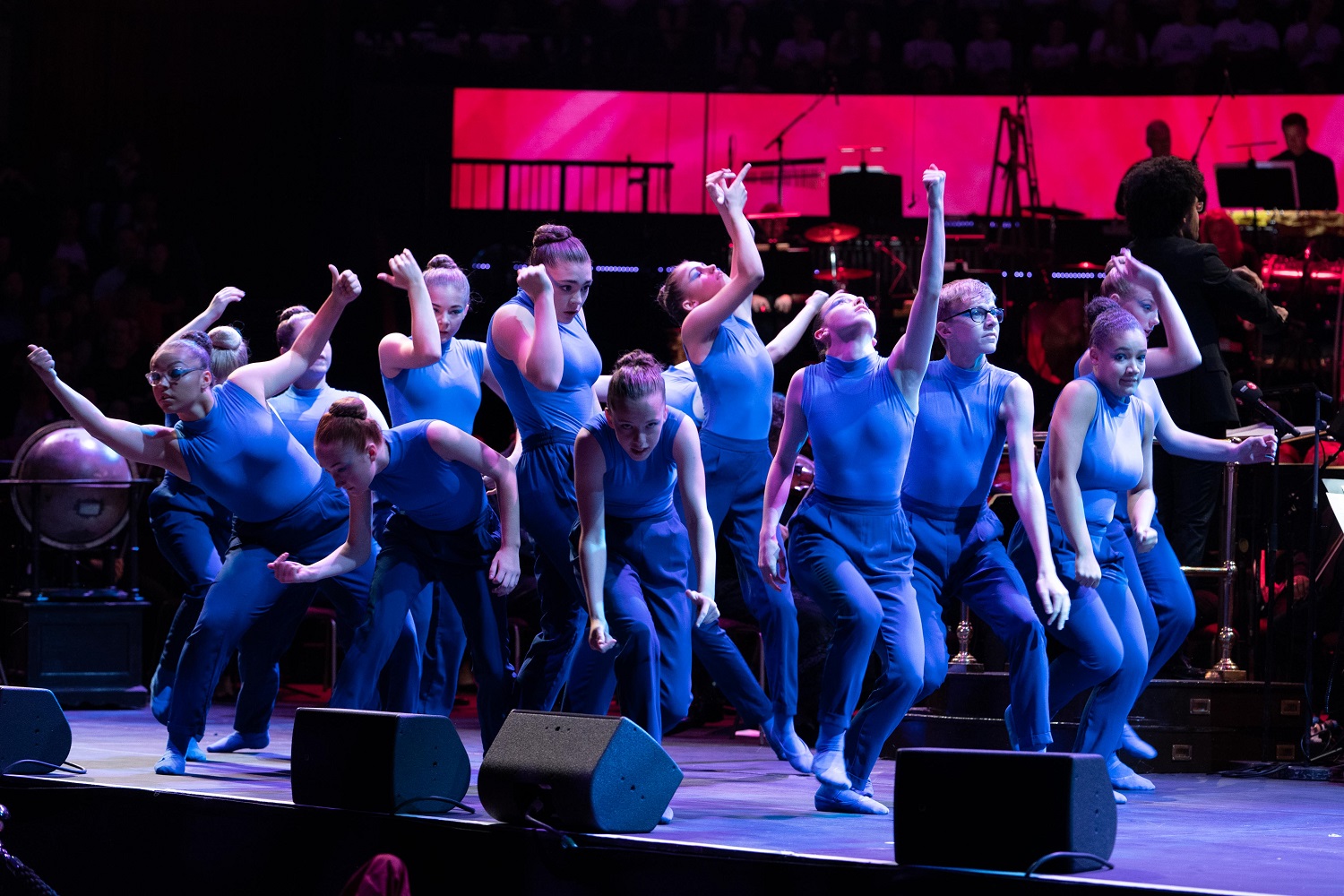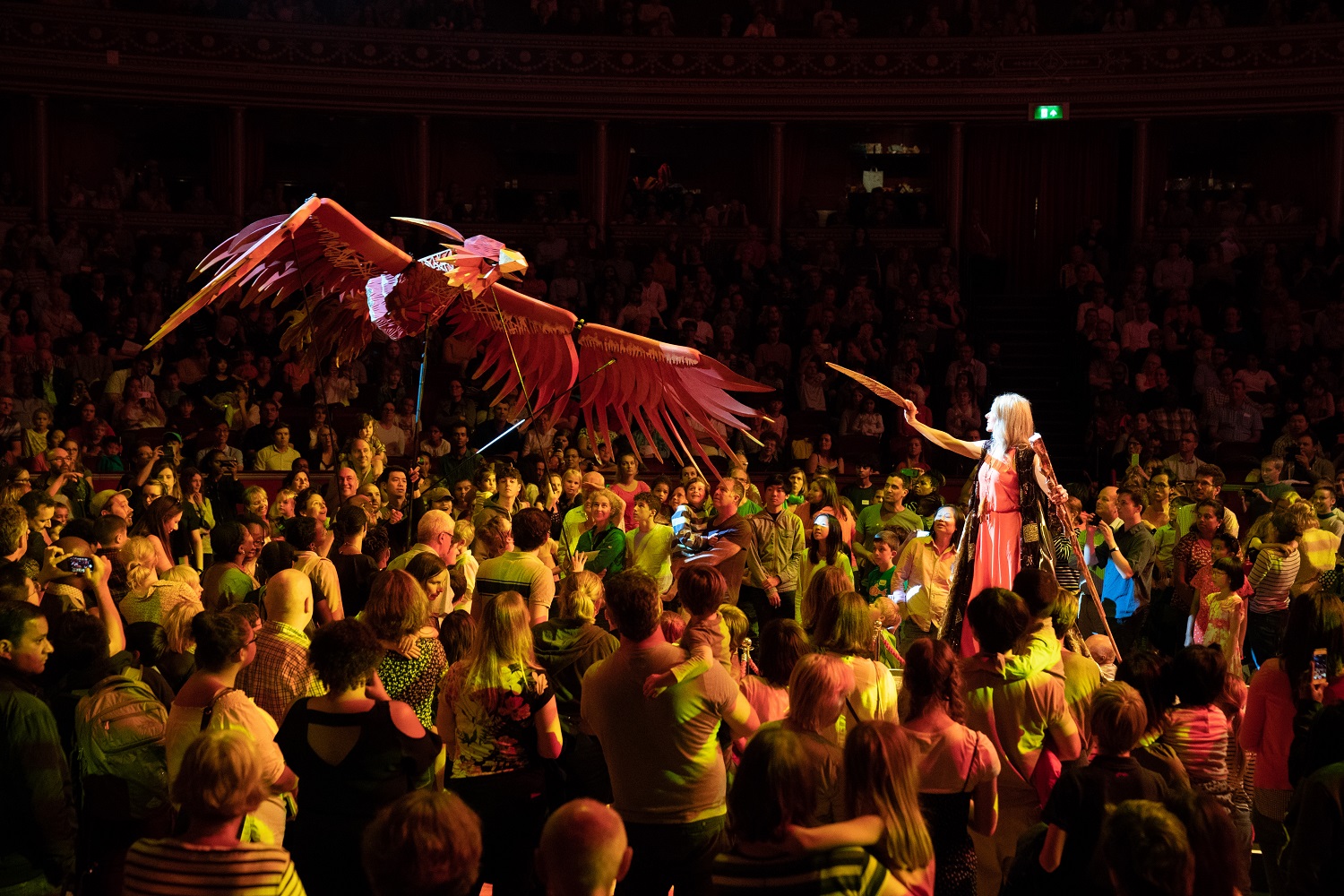Prom 19, Ten Pieces review – creative format engages young audiences | reviews, news & interviews
Prom 19, Ten Pieces review – creative format engages young audiences
Prom 19, Ten Pieces review – creative format engages young audiences
Fifth incarnation of the deservedly popular Proms children’s concerts

Children’s concerts are a tricky business, but the BBC has hit on a good formula with its Ten Pieces project, now in its fifth year.
In the first year, 2014, the concert ended with the appearance of a spectacular firebird puppet (pictured bottom), paraded above the arena to Stravinsky’s music. It made a return this year as the finale, with all of the preceding narrative about coaxing it back. To this end, Naomi Wilkinson played the Spell Caster, Josie Lawrence the eccentric ornithologist and Paapa Essiedu, Joseph Bologne (all pictured above), an 18th-century composer of African descent, whose First Symphony featured on the programme. The whole concept was paper thin, allowing the focus to remain on the music. Previous Proms children’s concerts have included acting or audacious video displays to accompany the music, which invariably distracted. More modest video animations were included this year, but they never upstaged the music, which held the concentration of the young audience.
The programme was a good mix of popular classics and new works, mostly connected with community projects. The BBC Symphony Orchestra were on lively form for Rafael Payare, whose sleek, dynamic conducting brought welcome vigour to these familiar works.
The classics included Finlandia, Hoe-down from Copland’s Rodeo (the trumpet section wearing cowboy hats), the Waltz of the Flowers, and the opening of Carmina Burana. This featured the Ten Pieces Children’s Choir, brought together from youth choirs founded as part of the project. They were bolstered by the BBC Singers, but even so, sounded impressively weighty and precise, easily mistakable for an adult chorus.

Other works were linked to education projects, some of them very creative. London Music Masters, an inner city music education charity, fielded an impressive young violin ensemble to perform their own addition to the Enigma Variations. A new piece from Mason Bates, The Á Bao A Qu, was written to accompany a performance by the Phoenix Dance Theatre’s Youth Academy (pictured above). The music was decidedly Russian-period Stravinsky, and the choreography reminiscent of The Rite of Spring, elegantly presented by the young dancers. Another collaboration was with English PEN, an organisation campaigning for human rights and freedom of expression. They had organised a poem to be read by children from refugee backgrounds about the idea of home. This was tied in to a performance of the second movement of the New World Symphony, with an itinerant Alison Teale playing the cor anglais from around the arena. Although well recited, this whole segment felt slow, letting the otherwise steady pace of the concert sag. That said, the young audience sat in rapt silence throughout, so perhaps it was just me.
On a similar subject, Kerry Andrew’s No Place Like took children’s ideas of home as the basis for an unaccompanied choral work, again performed with impressive assurance by the Ten Pieces Children’s Choir. This was another aspect of the programme that had appeared in previous events, but well justified repetition.
The Firebird, too, deserves to become an icon for this project, and its appearance at the end made for a memorable finale (pictured above). As in previous years, the overall impression was of a diverse format where most things worked and the few less engaging numbers didn’t seriously detract. The casual atmosphere fostered at the Albert Hall was also welcome, and not for the first time I left wishing that classical concerts for grown-ups were as informal and entertaining as this.
More classical music reviews on theartsdesk
rating
Explore topics
Share this article
The future of Arts Journalism
You can stop theartsdesk.com closing!
We urgently need financing to survive. Our fundraising drive has thus far raised £49,000 but we need to reach £100,000 or we will be forced to close. Please contribute here: https://gofund.me/c3f6033d
And if you can forward this information to anyone who might assist, we’d be grateful.

Subscribe to theartsdesk.com
Thank you for continuing to read our work on theartsdesk.com. For unlimited access to every article in its entirety, including our archive of more than 15,000 pieces, we're asking for £5 per month or £40 per year. We feel it's a very good deal, and hope you do too.
To take a subscription now simply click here.
And if you're looking for that extra gift for a friend or family member, why not treat them to a theartsdesk.com gift subscription?
more Classical music
 First Person: clarinettist Oliver Pashley on the new horizons of The Hermes Experiment's latest album
Compositions by members of this unusual quartet feature for the first time
First Person: clarinettist Oliver Pashley on the new horizons of The Hermes Experiment's latest album
Compositions by members of this unusual quartet feature for the first time
 Gesualdo Passione, Les Arts Florissants, Amala Dior Company, Barbican review - inspired collaboration excavates the music's humanity
At times it was like watching an anarchic religious procession
Gesualdo Passione, Les Arts Florissants, Amala Dior Company, Barbican review - inspired collaboration excavates the music's humanity
At times it was like watching an anarchic religious procession
 Classical CDs: Camels, concrete and cabaret
An influential American composer's 90th birthday box, plus British piano concertos and a father-and-son duo
Classical CDs: Camels, concrete and cabaret
An influential American composer's 90th birthday box, plus British piano concertos and a father-and-son duo
 Cockerham, Manchester Camerata, Sheen, Martin Harris Centre, Manchester review - re-enacting the dawn of modernism
Two UK premieres added to three miniatures from a seminal event of January 1914
Cockerham, Manchester Camerata, Sheen, Martin Harris Centre, Manchester review - re-enacting the dawn of modernism
Two UK premieres added to three miniatures from a seminal event of January 1914
 Kempf, Brno Philharmonic, Davies, Bridgewater Hall, Manchester review - European tradition meets American jazz
Bouncing Czechs enjoy their Gershwin and Brubeck alongside Janáček and Dvořák
Kempf, Brno Philharmonic, Davies, Bridgewater Hall, Manchester review - European tradition meets American jazz
Bouncing Czechs enjoy their Gershwin and Brubeck alongside Janáček and Dvořák
 Solomon, OAE, Butt, QEH review - daft Biblical whitewashing with great choruses
Even a top soprano and mezzo can’t make this Handel paean wholly convincing
Solomon, OAE, Butt, QEH review - daft Biblical whitewashing with great choruses
Even a top soprano and mezzo can’t make this Handel paean wholly convincing
 Two-Piano Gala, Kings Place review - shining constellations
London Piano Festival curators and illustrious friends entertain and enlighten
Two-Piano Gala, Kings Place review - shining constellations
London Piano Festival curators and illustrious friends entertain and enlighten
 Echo Vocal Ensemble, Latto, Union Chapel review - eclectic choral programme garlanded with dance
Beautiful singing at the heart of an imaginative and stylistically varied concert
Echo Vocal Ensemble, Latto, Union Chapel review - eclectic choral programme garlanded with dance
Beautiful singing at the heart of an imaginative and stylistically varied concert
 Scott, Irish Baroque Orchestra, Whelan, RIAM, Dublin review - towards a Mozart masterpiece
Characteristic joy and enlightenment from this team, but a valveless horn brings problems
Scott, Irish Baroque Orchestra, Whelan, RIAM, Dublin review - towards a Mozart masterpiece
Characteristic joy and enlightenment from this team, but a valveless horn brings problems
 Classical CDs: Voice flutes, flugelhorns and froth
Baroque sonatas, English orchestral music and an emotionally-charged vocal recital
Classical CDs: Voice flutes, flugelhorns and froth
Baroque sonatas, English orchestral music and an emotionally-charged vocal recital
 Kanneh-Mason, Britten Sinfonia, Shave, Milton Court - a grin and a big beaming smile
A pair of striking contemporary pieces alongside two old favourites
Kanneh-Mason, Britten Sinfonia, Shave, Milton Court - a grin and a big beaming smile
A pair of striking contemporary pieces alongside two old favourites

Add comment